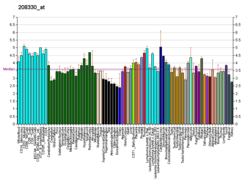ALX4
Homeobox protein aristaless-like 4 is a protein that in humans is encoded by the ALX4 gene.[5][6][7] Alx4 belongs to the group-1 aristaless-related genes, a majority of which are linked to the development of the craniofacial and/or appendicular skeleton, along with PRRX1, SHOX, ALX3, and CART1.[8] The Alx4 protein acts as a transcriptional activator and is predominantly expressed in the mesenchyme of the developing embryonic limb buds.[9][8][10] Transcripts of this gene are detectable in the lateral plate mesoderm just prior to limb induction. Alx4 expression plays a major role in the determination of spatial orientation of the growing limb bud by aiding in the establishment of anteroposterior polarity of the limb.[9][10][11] It does this by working in conjunction with Gli3 and dHand to restrict the expression of Sonic Hedgehog (SHh) to the posterior mesenchyme, which will eventually give rise to the Zone of Polarizing Activity (ZPA).[12] This gene has been proven to be allelic with mutations and deletions giving rise to a host of craniofacial dismorphologies and several forms of polydactyly in mammalian development.[8][13] A mouse-model knockout of this gene, dubbed Strong's luxoid, was originally created by Forstheofel in the 1960s and has been extensively studied to understand the partial and complete loss-of-function properties of this gene.[8][9][11][12][13][14]
Interactions
ALX4 has been shown to interact with Lymphoid enhancer-binding factor 1.[15]
References
- GRCh38: Ensembl release 89: ENSG00000052850 - Ensembl, May 2017
- GRCm38: Ensembl release 89: ENSMUSG00000040310 - Ensembl, May 2017
- "Human PubMed Reference:". National Center for Biotechnology Information, U.S. National Library of Medicine.
- "Mouse PubMed Reference:". National Center for Biotechnology Information, U.S. National Library of Medicine.
- Wu YQ, Badano JL, McCaskill C, Vogel H, Potocki L, Shaffer LG (November 2000). "Haploinsufficiency of ALX4 as a potential cause of parietal foramina in the 11p11.2 contiguous gene-deletion syndrome". American Journal of Human Genetics. 67 (5): 1327–32. doi:10.1016/S0002-9297(07)62963-2. PMC 1288575. PMID 11017806.
- Bartsch O, Wuyts W, Van Hul W, Hecht JT, Meinecke P, Hogue D, Werner W, Zabel B, Hinkel GK, Powell CM, Shaffer LG, Willems PJ (April 1996). "Delineation of a contiguous gene syndrome with multiple exostoses, enlarged parietal foramina, craniofacial dysostosis, and mental retardation, caused by deletions in the short arm of chromosome 11". American Journal of Human Genetics. 58 (4): 734–42. PMC 1914683. PMID 8644736.
- "Entrez Gene: ALX4 aristaless-like homeobox 4".
- Meijlink F, Beverdam A, Brouwer A, Oosterveen TC, Berge DT (1999). "Vertebrate aristaless-related genes". The International Journal of Developmental Biology. 43 (7): 651–63. PMID 10668975.
- Takahashi M, Tamura K, Büscher D, Masuya H, Yonei-Tamura S, Matsumoto K, Naitoh-Matsuo M, Takeuchi J, Ogura K, Shiroishi T, Ogura T, Izpisúa Belmonte JC (November 1998). "The role of Alx-4 in the establishment of anteroposterior polarity during vertebrate limb development". Development. 125 (22): 4417–25. PMID 9778501.
- Panman L, Drenth T, Tewelscher P, Zuniga A, Zeller R (2004-07-01). "Genetic interaction of Gli3 and Alx4 during limb development". The International Journal of Developmental Biology. 49 (4): 443–8. doi:10.1387/ijdb.051984lp. PMID 15968591.
- Kuijper S, Feitsma H, Sheth R, Korving J, Reijnen M, Meijlink F (September 2005). "Function and regulation of Alx4 in limb development: complex genetic interactions with Gli3 and Shh". Developmental Biology. 285 (2): 533–44. doi:10.1016/j.ydbio.2005.06.017. PMID 16039644.
- Niswander L (2002). "Interplay between the molecular signals that control vertebrate limb development". The International Journal of Developmental Biology. 46 (7): 877–81. PMID 12455624.
- Kayserili H, Uz E, Niessen C, Vargel I, Alanay Y, Tuncbilek G, Yigit G, Uyguner O, Candan S, Okur H, Kaygin S, Balci S, Mavili E, Alikasifoglu M, Haase I, Wollnik B, Akarsu NA (November 2009). "ALX4 dysfunction disrupts craniofacial and epidermal development". Human Molecular Genetics. 18 (22): 4357–66. doi:10.1093/hmg/ddp391. PMID 19692347.
- Forsthoefel PF (November 1963). "The embryological development of the effects of Strong's luxoid gene in the mouse". Journal of Morphology. 113 (3): 427–51. doi:10.1002/jmor.1051130307. PMID 14079603.
- Boras K, Hamel PA (January 2002). "Alx4 binding to LEF-1 regulates N-CAM promoter activity". The Journal of Biological Chemistry. 277 (2): 1120–7. doi:10.1074/jbc.M109912200. PMID 11696550.
Further reading
- Qu S, Tucker SC, Zhao Q, deCrombrugghe B, Wisdom R (January 1999). "Physical and genetic interactions between Alx4 and Cart1". Development. 126 (2): 359–69. PMID 9847249.
- Wuyts W, Cleiren E, Homfray T, Rasore-Quartino A, Vanhoenacker F, Van Hul W (December 2000). "The ALX4 homeobox gene is mutated in patients with ossification defects of the skull (foramina parietalia permagna, OMIM 168500)". Journal of Medical Genetics. 37 (12): 916–20. doi:10.1136/jmg.37.12.916. PMC 1734509. PMID 11106354.
- Mavrogiannis LA, Antonopoulou I, Baxová A, Kutílek S, Kim CA, Sugayama SM, Salamanca A, Wall SA, Morriss-Kay GM, Wilkie AO (January 2001). "Haploinsufficiency of the human homeobox gene ALX4 causes skull ossification defects". Nature Genetics. 27 (1): 17–8. doi:10.1038/83703. PMID 11137991.
- Nagase T, Nakayama M, Nakajima D, Kikuno R, Ohara O (April 2001). "Prediction of the coding sequences of unidentified human genes. XX. The complete sequences of 100 new cDNA clones from brain which code for large proteins in vitro". DNA Research. 8 (2): 85–95. doi:10.1093/dnares/8.2.85. PMID 11347906.
- Boras K, Hamel PA (January 2002). "Alx4 binding to LEF-1 regulates N-CAM promoter activity". The Journal of Biological Chemistry. 277 (2): 1120–7. doi:10.1074/jbc.M109912200. PMID 11696550.
- Wakui K, Gregato G, Ballif BC, Glotzbach CD, Bailey KA, Kuo PL, Sue WC, Sheffield LJ, Irons M, Gomez EG, Hecht JT, Potocki L, Shaffer LG (May 2005). "Construction of a natural panel of 11p11.2 deletions and further delineation of the critical region involved in Potocki-Shaffer syndrome". European Journal of Human Genetics. 13 (5): 528–40. doi:10.1038/sj.ejhg.5201366. PMID 15852040.
- Mavrogiannis LA, Taylor IB, Davies SJ, Ramos FJ, Olivares JL, Wilkie AO (February 2006). "Enlarged parietal foramina caused by mutations in the homeobox genes ALX4 and MSX2: from genotype to phenotype". European Journal of Human Genetics. 14 (2): 151–8. doi:10.1038/sj.ejhg.5201526. PMC 1477589. PMID 16319823.
External links
- GeneReviews/NCBI/NIH/UW entry on Enlarged Parietal Foramina/Cranium Bifidum
- Human ALX4 genome location and ALX4 gene details page in the UCSC Genome Browser.




